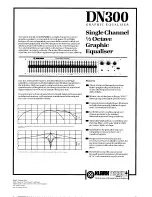
EQ HINTS
We usually give a few hints about tricks commonly used with our products. With an
EQ of this type it is not so likely you need much help.
The most common question we get asked about our Pultecs is "Why not a boost/cut
knob in each band?". We don't know why it was designed that way for sure. It was designed
in the 1930's by Western Electric to improve voice through telephone lines. We believe it was
done this way because it was the most practical in a simple passive design. This was before
op-amps and Baxandall type cut / boost circuits were common. We do know how to design
& build that style but it wouldn't be a Pultec, it would need twice as many parts or not be
passive. Standard EQs are easy - Our customers requested Pultecs when they could have
anything except a new well built Pultec. David and EveAnna flew to New Jersey to request
permission from Eugene Shenk of Pulse Technologies to use the circuits and name. Mr Shenk
was gracious enough to give it to them. Permission was also obtained from Western Electric
because they originated this passive EQ. We just improved it for a different era.
The obvious application is voice. Many acoustic and electric instruments benefit
from the choice of frequencies and bandwidths. We know it has been the magic touch on
harmonicas, acoustic guitars, and violins. Because almost all instruments have a reasonable
amount of mids, it can be handy very often. We suggest it in combination with another EQ
like the Manley Pultec EQP1-A which focuses on lows and highs. The frequencies
complement each other. This combination has proved powerful and flexible for mastering.
Many of the most recognised engineers suggest cutting rather than boosting.
According to them, it sounds like less phase shift and resonance. They would start by dipping
a little in the 150 to 1.5K area and not by boosting lows, then highs, then.... One obvious
advantage to this is maximised headroom. The Mid Dip section is great for this approach.
Another advanced technique of EQ is to approach it "in the mix" rather than "soloed'
and more as an arrangement tool than making every single sound huge. It is based on finding
optimum areas in the spectrum of the mix to emphasize each sound. The denser the
arrangement, the more this may be needed. It is most difficult when the band participates in
the mix. Each player wants to hear thier instrument oversized, up-front and dramatic.
Producers and engineers who can hear, in their head, what the mix should be with one or two
passes of the tape have the method. The Mid Eq has proven to be a great tool for that approach.
The opposite approach is every sound is big, and most of the tracks are muted. However when
one gets great arrangements & great musicians playing together these "tricks" are not really
needed much. A hit song will probably be a hit regardless of your efforts or the mix but the
best memories is when it all clicked.
The Mid Pultec has pretty narrow bandwidths, appropriate for fine-tuning or creating
some unusual character. Approach it like a fine tip paint brush. If what you need is a roller
brush, save the Mid EQ for something else like the final touch-ups. Try it on percussion, snare
or sax. These instruments often challenge the transient accuracy of solid state Eqs. They
might take on a smeared, edgy or pink noise quality. The better the monitor system the more
obvious this can be heard. Manley's circuits may sound quicker, cleaner & warmer.
4
Содержание Enhanced Pultec Mid Frequency Equalizer
Страница 1: ...MANLEY LABORATORIES INC OWNER S MANUAL ENHANCED MID FREQUENCY PULTEC EQUALIZER...
Страница 11: ......
Страница 15: ......

































